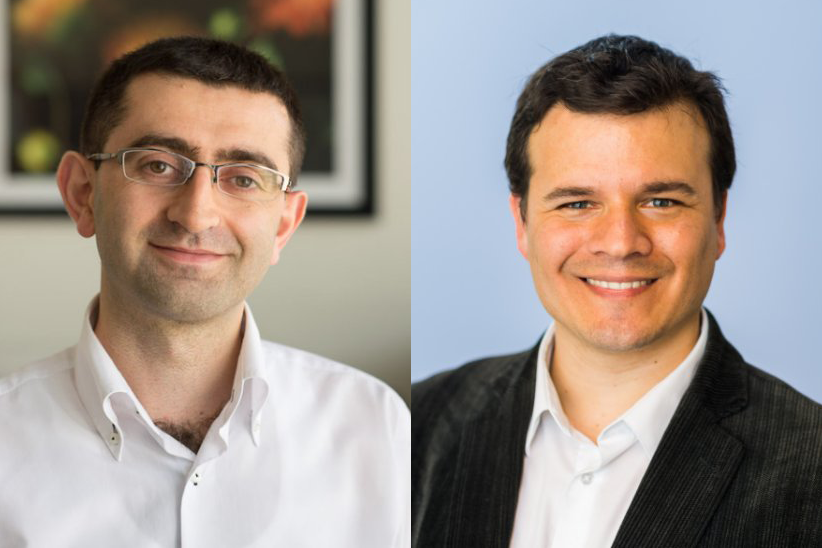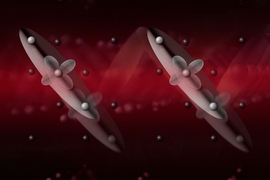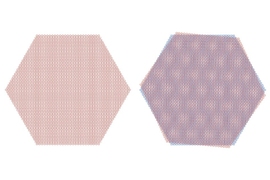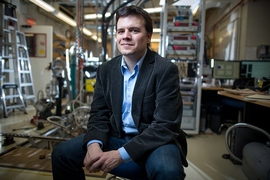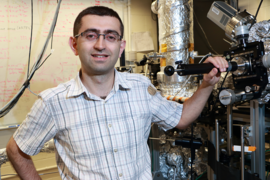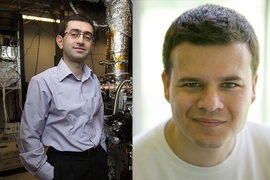Physics professors Nuh Gedik and Pablo Jarillo-Herrero have been named Experimental Investigators in Quantum Materials by the Gordon and Betty Moore Foundation.
The two are among 20 winners nationwide of the foundation's Emergent Phenomena in Quantum Systems (EPiQS) Initiative. Each will receive a five-year, $1.6 million unrestricted grant to support their research in quantum materials.
Gedik’s research centers on using advanced optical techniques for probing and controlling properties of quantum materials. He will use his grant to search for novel, light-induced phases in these systems.
“These materials display fascinating but poorly understood properties, such as high-temperature superconductivity or topological protection,” says Gedik. “We use ultrafast laser pulses to make femtosecond movies of electrons and atoms inside these systems to understand the mechanism behind their exotic behavior. Our ultimate goal is to use light as a controllable tuning parameter (just as magnetic field or pressure) to switch between equilibrium phases and to engineer new light-induced states with no equilibrium counterparts.”
Jarillo-Herrero, the Cecil and Ida Green Professor of Physics, leads a laboratory that uses quantum electronic transport and optoelectronic techniques to investigate novel 2D materials and heterostructures, with a focus on emergent correlated and topological phenomena/phases resulting from the interplay between unusual electronic structures and electron interaction effects.
“This Moore Foundation award will allow my group to focus on a novel experimental platform called twistronics, where a new degree of freedom, namely the twist angle between two stacked 2D crystalline lattices, enables the exploration of a plethora of intriguing quantum mechanical effects, such as superconductivity. This emergent platform may provide important clues about the origin of many of the most fascinating phases of matter present in the universe, as well as the potential engineering of these phases to create new quantum technologies.”
The EPiQS Initiative of the Gordon and Betty Moore Foundation aims to stimulate experimental research in the physics of quantum materials by providing some of the field’s most creative scientists with freedom to take risks and flexibility for agile change of research direction. The collective impact of these investigators will produce a more comprehensive understanding of the fundamental organizing principles of complex quantum matter in solids.
“The Experimental Investigator awards are the largest grant portfolio within the EPiQS initiative,” says Amalia Fernandez-Pañella, program officer of the EPiQS Initiative. “We expect that such substantial, stable, and flexible support will propel quantum materials research forward and unleash the creativity of the investigators.”
The cohort’s research will cover a broad spectrum of research questions, types of materials systems, and complementary experimental approaches. The investigators will advance experimental probes of quantum states in materials; elucidate emergent phenomena observed in systems with strong electron interactions; investigate light-induced states of matter; explore the vast space of two-dimensional layered structures; and illuminate the role of quantum entanglement in exotic systems such as quantum spin liquids. In addition, the investigators will participate in EPiQS community-building activities, which include investigator symposia, topical workshops, and the QuantEmX scientist exchange program.
Since 2013, EPiQS has supported an integrated research program that includes materials synthesis, experiment, and theory, and that crosses the boundaries between physics, chemistry, and materials science. The second phase of the initiative was kicked off earlier this year with the launch of two major grant portfolios: Materials Synthesis Investigators and Theory Centers. The 20 newly inaugurated experimental investigators will join these grantees to form a vibrant, collaborative community that strives to push the entire field toward a new frontier.
“The first cohort of EPiQS Experimental Investigators made advances that changed the landscape of quantum materials, and I expect no less from this second cohort. Emergent phenomena appear when a large number of constituents interact strongly, whether these constituents are electrons in materials, or the brilliant scientists trying to crack the mysteries of materials.” says Dušan Pejaković, director of the EPiQS Initiative. Gedik and Jarillo-Herrero were also part of the first cohort of EPIQS awardees.
The Gordon and Betty Moore Foundation fosters pathbreaking scientific discovery, environmental conservation, patient care improvements, and preservation of the special character of the San Francisco Bay Area.
